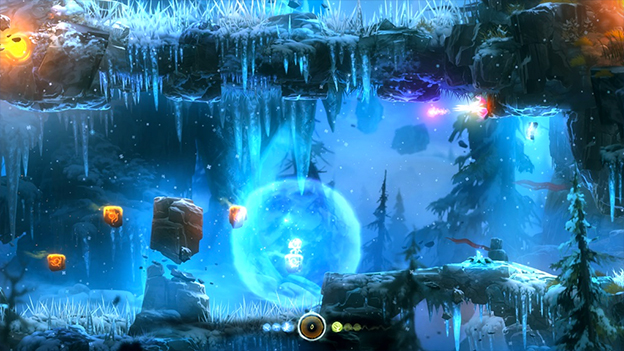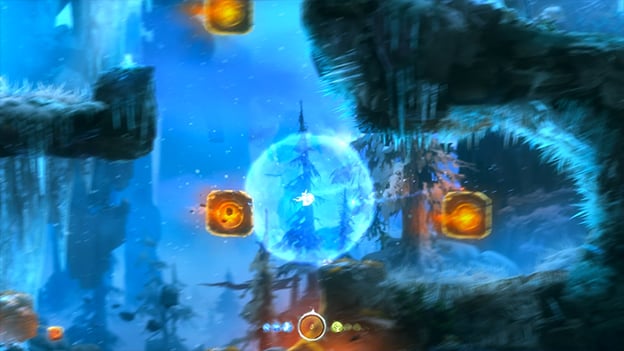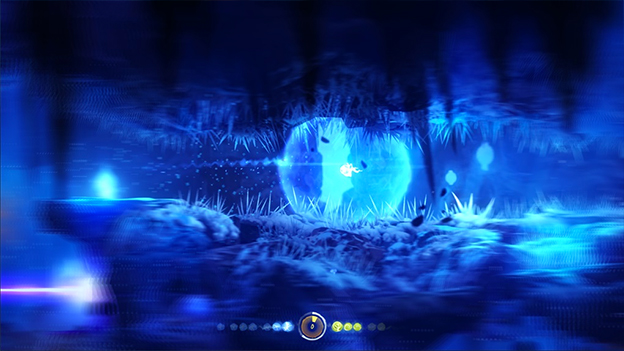The Eyes of the Blind Shall be Opened
We have seen a resurgence of late with two-dimensional platfomers, from those embracing bit-era technology such as Shovel Knight to others stretching the graphical limits with modern techniques like the renewed Rayman series. Ori and the Blind Forest fits in the latter category and rests at the top of the list. The breathtaking handcrafted environments, sublime musical score, tight controls, and progressively challenging gameplay are weaved into a story that tugs at the heartstrings from the prologue, only strengthening the emotional bond as the journey unfolds.

Plucked from the venerable Spirit Tree in the wrath of a great storm, the fledgling spirit Ori is whisked through the forest of Nibel, coming to rest near a sloth-like creature named Naru. A nurturing soul, Naru cares for the lost child as the two form a tender relationship. Heedless to the calls of his true parentage, Ori and his surrogate mother witness a cataclysmic blight that saps the life from the world, decaying the flora, perverting the fauna, and displacing the two in tragedy. Forced to struggle onwards in solitude, Ori’s journey shapes into one of maturity and self-reliance. Their separation is disheartening on an emotional level, but it also removes the possibility of symbiotic gameplay between the two physically different characters, which could have provided an interesting juxtaposition.
This criticism is quickly dismissed, however, when Ori showcases the breadth of his skills, sure to satiate the thirst of any gamer looking for a challenging platforming experience. Your trek begins with no more than the ability to jump, which itself is only for traversing the environment. You soon discover your first attack – spirit projectiles that hone in on enemies at a relatively close range. As you progress, new skills such as double and triple jumps, charged burst attacks, dash maneuvers, gliding, and more cohere into a stunning amalgamation of tools to challenge both the environment and the denizens within. The game does a masterful job of introducing each new skill and then releasing the reins, allowing you to discover how each power can be manipulated alone or in tandem with other skills.

The background gracefully transitions as Ori returns life to the forest, but also delivers a world where every frame feels like one that has been newly crafted, not revisited. Whether its scaling the core of a giant tree, braving lava filled caverns, or gingerly moving through icicle pierced mountains, you’ll always find a new configuration of hazards and enemies to best. Controlling Ori and using his skills is as smooth as the flowing animations. Abilities can be canceled into each other, ensuring that each success and failure is decided by your skill alone. The game delivers a beautiful balance of somewhat relaxed exploration heightened with segments of high stress action, which are wholly satisfying when surmounted.
A unique and clever feature of Ori and the Blind Forest puts the checkpoint system under your control. Apart from a few fixed Spirit Wells, checkpoints are created through the use of the Soul Link ability. This save skill requires the same energy resource that is used for other abilities, thus challenging your ego on how far you will tempt Ori’s resolve before setting down an updated Soul Link.

Developer Moon Studios has been upfront about taking inspiration from classic platformers when creating Ori and the Blind Forest , describing its genre as “Metroidvania.” Elements from both the Metroid and Castlevania series are readily apparent. The world, for one, is completely connected, save for a few dedicated “dungeons.” Opening the map reveals a detailed cross section of Nibel, complete with a legend to identify important sites and items. Explored sections are nicely colored in while uncharted areas remain gray, with special Map Stones revealing new sections when obtained. There is also a steady increase in your maximum energy and life through the acquisition of Energy Cells and Life Cells.
The game provides a light RPG element through a three-branched skill tree with purchasable upgrades. Attacks can be enhanced, health recovery can be bolstered, and the map can be updated with the locations of collectables. Each upgrade provides a noticeable improvement in the gameplay. The system is fairly linear, with the ability to unlock the entire tree in a single playthrough, eliminating any value of replayability for the possibility of a different character composition. You can, however, replay to improve your spot on the leaderboard, which tracks completion time, completion percentage, and the total number of deaths.

You may find yourself replaying Ori and the Blind Forest several times just to bask in its picturesque visuals. Enough cannot be said about how gorgeous this game is. It dabs into every part of the color spectrum. From the lifeless grays and browns to the blooming greens and blues, the artwork takes on a journey of its own, only adding to the emotional attachment. Everything moves with grace, showcasing deft skill with animation. It defies photorealism as the be-all and end-all of graphical achievement, presenting the most stunning display at least these eyes have ever beheld.
The musical score is impressively stunning, hitting all the right notes in all the right spots. The music flows with the story, with a softly played piano moistening the tear ducts during the tragic prologue, woodwinds chiming in as life springs back, and intense allegros of violins and percussion during high-action sequences. The somber, Huttese-like narration from the Spirit Tree provides a verbal account of Ori’s important accomplishments. Ori himself is limited to chirps and squeals, but alongside the music they are more than effective in displaying his current emotional state.
Ori and the Blind Forest is the first fully realized endeavor from developer Moon Studios. With pristine quality in every facet of the game, it is a monumental premier that will hopefully be well-received by all and provide the financial support for the company to create more fantastic games. Microsoft deserves high marks for partnering with this independent developer, a relationship we can only hope gets nurtured moving forward. This gem of a title will captivate your heart and test your skill, providing a soul-inspiring experience that will remain long after the game has been put down.
RATING OUT OF 5 RATING DESCRIPTION 5.0 Graphics
Every frame is simply breathtaking, and the animations are beyond smooth. The game urges you onwards, but begs you to stop and enjoy the magnificent view. 5.0 Control
Each newly acquired ability compounds the skill level required, and the game keeps pace with tight controls and a level design that works with them. 5.0 Music / Sound FX / Voice Acting
Every moment, from a serene swim in a newly purified lake, to escaping an encroaching wave of lava, is perfectly orchestrated. The subtle squeaks from Ori make you care for him all the more. 4.6 Play Value
A perfectly balanced pace and satisfying progression is marred only slightly by a linear ability tree. You’ll likely be drawn back in after completing the game, if only to bask in its aesthetic beauty once more. 4.9 Overall Rating – Must Buy
Not an average. See Rating legend below for a final score breakdown.
| Review Rating Legend | |||
|---|---|---|---|
| 0.1 – 1.9 = Avoid | 2.5 – 2.9 = Average | 3.5 – 3.9 = Good | 4.5 – 4.9 = Must Buy |
| 2.0 – 2.4 = Poor | 3.0 – 3.4 = Fair | 4.0 – 4.4 = Great | 5.0 = The Best |
Game Features:
